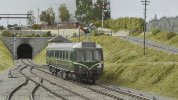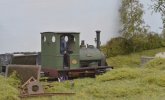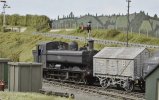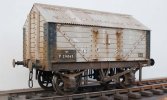You are using an out of date browser. It may not display this or other websites correctly.
You should upgrade or use an alternative browser.
You should upgrade or use an alternative browser.
7mm Melcombe Magna
- Thread starter Quintus
- Start date
Quintus
Western Thunderer
Hi Graham,Mike,
Please describe how you have achieved the washed-out appearance and the texture of the yard surface... and the materials used.
thank you, Graham
See post #16 on this thread.
Regards
Mike
Dog Star
Western Thunderer
The yard ballast is a mix of Woodland scenics fine cinders and garden earth ground to a powder.
To check my understanding, the foundation layer is foam underlay and that foam underlay is coloured with a mix of Greenscene texture paints. The painted foam is then covered with a mix of Woodland scenics and garden soil (why not one of the WS soil products?).The foam underlay used for the yard surface has Greenscene textured paint stippled on, I used "Yard filth" and "Dark Tarmac" mixed together.
How is the WS cinders "fixed" to the underlay?
thanks, Graham
Quintus
Western Thunderer
Hi Graham,To check my understanding, the foundation layer is foam underlay and that foam underlay is coloured with a mix of Greenscene texture paints. The painted foam is then covered with a mix of Woodland scenics and garden soil (why not one of the WS soil products?).
How is the WS cinders "fixed" to the underlay?
thanks, Graham
Sorry if you.have been mislead. I will try to explain in detail.
I will refer to underlay as that which you may use beneath the track, and foam underlay which is used on top of any previous underlay.
If you plan to use a track underlay on your layout ( Cork, foam, w.h.y ) then lay this over the whole of the area you wish the yard to be (track and yard area.) After laying the track, lay the foam underlay (either on top of any underlay you may have used, or directly on the baseboard surface if you have not) where you want the yard surface to be. Butt this underlay up to the sleeper ends. Using 3mm thick material will be the same height as the tops of the sleepers. This will give the sleepers that "buried" look, as we don't want a ballast shoulder in the goods yard. The ballast (W.S and seived garden soil) is then laid between the sleepers as normal. The side of the track underlay is butted up to is also ballasted, but only in the voids between the sleepers up to the edge of the underlay. Make sure the ballast is level with the top of the sleepers. The ballast should now be more or less level with the top of the foam underlay.
The Greenscenes textured "gunge" is then stippled onto the foam underlay and blended in where the track ballast meets the foam underlay, which represents the actual yard surface.
I used sieved garden soil rather then W.S, as I have a free lifetime supply!
Hope this helps, Please ask if you have any queries.
regards
Mike
3 LINK
Western Thunderer
Good morning Mike,
I also use sieved garden soil, I usually apply a thin layer of pva glue to the area and then just sprinkle on the soil, rubbing it in with my thumb and then vacuuming off any loose that hasn’t adhered. I was wondering what method you used to fix the soil, especially around the sleepers and chairs.
Martyn.
I also use sieved garden soil, I usually apply a thin layer of pva glue to the area and then just sprinkle on the soil, rubbing it in with my thumb and then vacuuming off any loose that hasn’t adhered. I was wondering what method you used to fix the soil, especially around the sleepers and chairs.
Martyn.
Quintus
Western Thunderer
Hi Martyn,
I fixed the earth mix between the sleepers in the usual way, lay the mix dry, dampen with water then dribble on dilute PVA from an eye dropper.
I find natural materials can work well, I used lime from a lime pit near the area modelled for the embankment at Waterloo Yard, and am particularly pleased with the result. Perhaps the best shot of this is glimpsed in post# 59.
Incidentally, I used the same method for this as you described to lay your earth.
regards
Mike
I fixed the earth mix between the sleepers in the usual way, lay the mix dry, dampen with water then dribble on dilute PVA from an eye dropper.
I find natural materials can work well, I used lime from a lime pit near the area modelled for the embankment at Waterloo Yard, and am particularly pleased with the result. Perhaps the best shot of this is glimpsed in post# 59.
Incidentally, I used the same method for this as you described to lay your earth.
regards
Mike
Osgood
Western Thunderer
I had meant to comment on that earlier Mike - having lived, breathed, and trampled it into the carpets over many years, I have never seen anything quite as realistic - texture and colour are everything and the bank accurately portrays a face subjected to frost over the years.
Quintus
Western Thunderer
I am not a huge diesel fan, although certain types are exempt from my prejudice towards them.
I built this pressed steel single unit (latterly class 121) from an Easy Build kit, which I managed to complete just before the Dapol one was released.
It runs very nicely, and often deputises for the Weymouth Auto on operating days.
It is seen here on the return journey.
I built this pressed steel single unit (latterly class 121) from an Easy Build kit, which I managed to complete just before the Dapol one was released.
It runs very nicely, and often deputises for the Weymouth Auto on operating days.
It is seen here on the return journey.

LarryG
Western Thunderer
That scene is so realistic, helped by the medium telephotos lens which was so often used by railway photographers. The inclined track adds interest to the scene.
My feeling haven't changed concerning DMU's. I rode home on one on the first day of DMU operation Manchester- Oldham- Rochdale and avoided them thereafter. However, a day in the cab of Met-Camm 'Daisy' many years later was thoroughly enjoyable.
My feeling haven't changed concerning DMU's. I rode home on one on the first day of DMU operation Manchester- Oldham- Rochdale and avoided them thereafter. However, a day in the cab of Met-Camm 'Daisy' many years later was thoroughly enjoyable.
Quintus
Western Thunderer
Thanks Larry, I remember as a youngster we would try and get to the seats at the front, getting a good view of the line ahead, providing the driver hadn't pulled the blinds down!That scene is so realistic, helped by the medium telephotos lens which was so often used by railway photographers. The inclined track adds interest to the scene.
My feeling haven't changed concerning DMU's. I rode home on one on the first day of DMU operation Manchester- Oldham- Rochdale and avoided them thereafter. However, a day in the cab of Met-Camm 'Daisy' many years later was thoroughly enjoyable.
Quintus
Western Thunderer
Returning for a moment to the Waterloo tramway, despite the industrial junk lying around, I have tried to create a rather sylvan setting between the bagging shed and the loading wharf. A visit to the lime works at Shillingstone just before it closed inspired the scene, where bits of discarded machinery lay in an otherwise totally rural environment. Here we see Peckett 0-6-0 "Jurassic" passing through the countryside.
The loco was built from a Locos n Stuff etched kit, and is powered by a flywheel fitted N20 gearmotor with 256:1 ratio.
The loco was built from a Locos n Stuff etched kit, and is powered by a flywheel fitted N20 gearmotor with 256:1 ratio.

Quintus
Western Thunderer
I don’t think there could have been many of these lime wagons around in the late 50's, but I do like them, so despite them being a bit out of period I have dreamt up various excuses for their presence at Melcombe Magna.
Here we see 3795 shunting one of them before departing with the daily pick up goods
Here we see 3795 shunting one of them before departing with the daily pick up goods

Osgood
Western Thunderer
Maybe corrugated was used for light weight and to keep water out? They're pretty big doors to swing up by hand.
The lime dust is a very strong alkaline - some surface rust through oxidation when the dust retained moisture but it would have generally kept the ironwork in good condition.
The lime dust is a very strong alkaline - some surface rust through oxidation when the dust retained moisture but it would have generally kept the ironwork in good condition.
Last edited:


